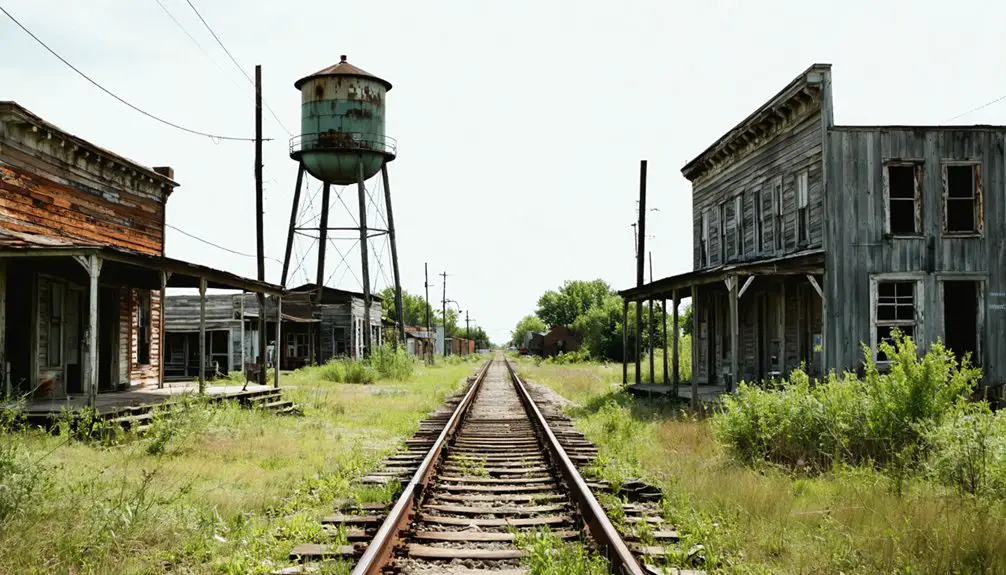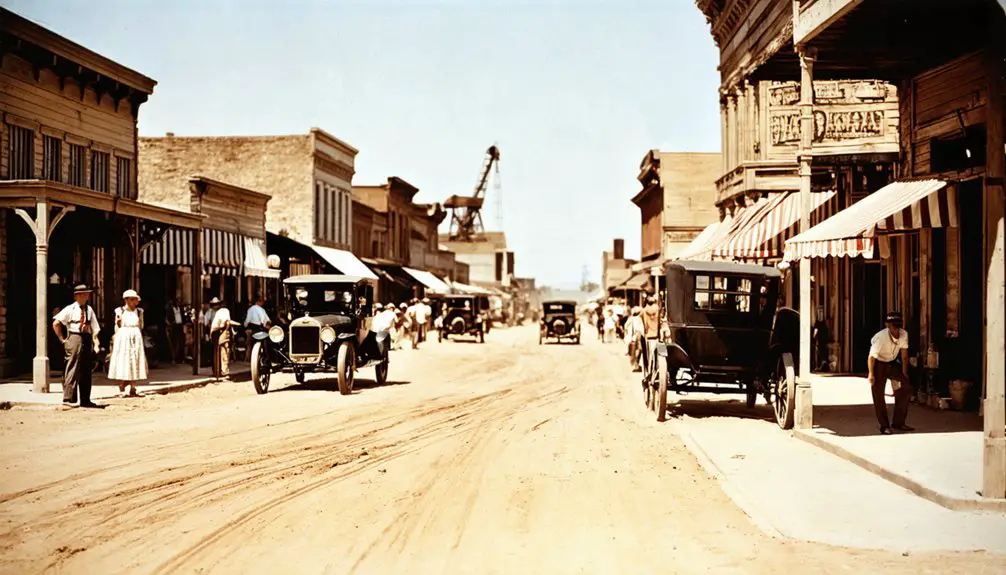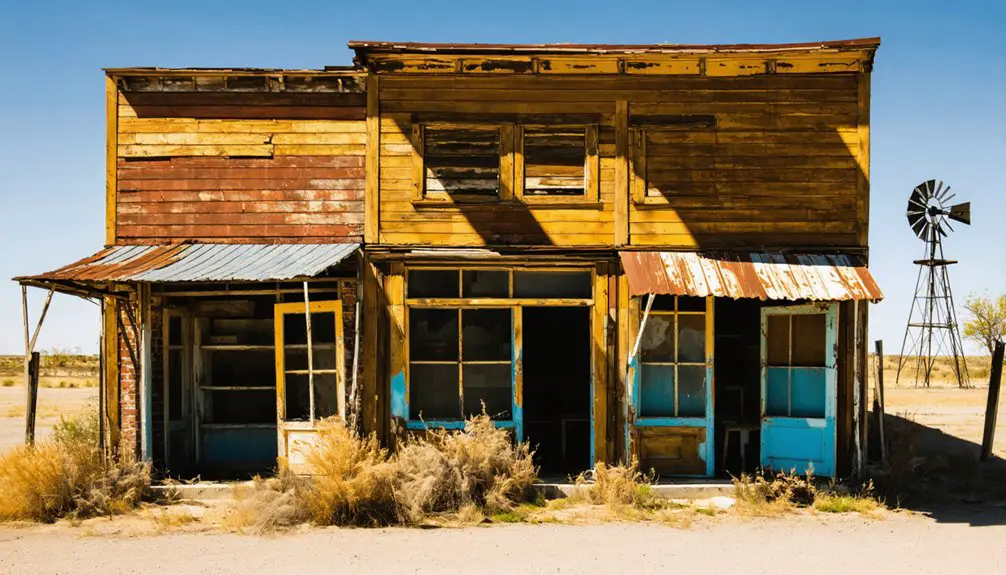You’ll find Anarene in Archer County, Texas – a ghost town established in 1908 as a coal transportation hub along the Wichita Falls and Southern Railroad. Named after Anna Laurene Graham, it flourished during the coal mining era and later oil boom, reaching nearly 100 residents in the 1920s. The Great Depression triggered its decline, and by 1955, the post office closed. Today, its haunting legacy lives on through “The Last Picture Show” and tells a deeper story of boom-and-bust America.
Key Takeaways
- Anarene, Texas was established in 1908 as a coal transportation hub, named after Anna Laurene Graham, daughter of pioneer J.M. Keen.
- The town peaked at 100 residents during 1920-1930, supported by coal mining and later oil production industries.
- Economic decline began during the Great Depression, reducing population from 100 to 20 by 1933.
- The town’s final decline occurred with coal production ending in 1942 and railroad station closure in 1951.
- Anarene gained cultural significance through “The Last Picture Show” film and Larry McMurtry’s novel depicting rural America’s decline.
The Birth of a Railroad Town

When the Wichita Falls and Southern Railroad expanded its operations in 1908, the town of Anarene emerged as a strategic coal transportation hub in Archer County, Texas.
You’ll find its origins tied to landowner Charles E. Graham, who granted the railroad its significant right of way, enabling the town’s establishment alongside the tracks.
Named after Anna Laurene Graham, daughter of pioneer J. M. Keen, Anarene quickly positioned itself as an essential link in the region’s coal transportation network.
Inheriting its name from Anna Laurene Graham, Anarene emerged as a vital coal transport hub in early Texas history.
The town’s creation coincided perfectly with the opening of the Belknap Coal Company’s Newcastle mine, establishing Anarene as a crucial stop for moving coal from pit to market.
This railroad expansion transformed what was once empty land into one of several strategic railroad towns dotting Archer County’s early 20th-century landscape. J. M. Keen began his local influence after serving as a Confederate Army veteran. The area remained largely unsettled until U.S. Army troops drove out American Indians.
J.M. Keen’s Legacy and Early Settlement
After serving in the Confederate Army, J.M. Keen returned to Texas in 1865 and established himself as a prominent rancher in Archer County.
You’ll find his influence throughout the region’s early development, from his extensive 15,000-head cattle operation to his family’s role in founding Anarene.
His marriage to Caledonia Isabella Beazley Dailey in 1867 helped forge important connections with other pioneer families, strengthening the growing settler community. The town was later named after Anna Laurene Graham, reflecting the deep ties between local families.
The ranch’s cattle were marked with a distinctive terrapin emblem brand, inspired by ancient rock art discovered at Terrapin Springs.
Confederate Veteran Settles West
During the post-Civil War era, Thomas Jefferson Keen emerged as a pivotal figure in East Texas settlement, having served in the Confederate Army from 1861 through the war’s end.
Like many Confederate veterans seeking new opportunities, he joined the westward Confederate migration into Texas frontier territories.
You’ll find Keen’s influence particularly strong in Daly’s, Texas, where he helped establish a thriving community alongside his father Joseph and stepmother Permelia Dailey Keen.
His marriage to widow Caledonia Isabella Beazley Dailey in 1867 strengthened local family networks, while his frontier leadership skills, honed during military service, proved invaluable in community building.
Together, they raised ten children – six of their own plus Caledonia’s four from her previous marriage – contributing to the settlement’s growth and stability. Their daughter Frances Irene Keen married Dr. Lewis Meriwether and had four children of her own, extending the family’s legacy in the region. Similar to La Vernia’s settlers, the family eventually shifted from cotton farming to cattle ranching due to economic pressures.
Local Pioneer’s Family Impact
As Confederate veteran J.M. Keen settled in Archer County, his impact on the region grew far beyond his initial cattle operations.
You’ll find his terrapin brand, inspired by ancient rock art near Olney, marked a herd that expanded to as many as 15,000 head. The Keen family’s economic contributions shaped south central Archer County’s development, particularly after 1908 when the railroad arrived.
Like his relative Abner Keen’s ministry, J.M.’s influence extended into community leadership and development. When Keen’s daughter Annie married Charlie Graham, the union bridged cattle and sheep ranching interests. The Wichita Falls Railroad became integral to the area’s growth.
Together, they helped establish the town of Anarene, named in Annie’s honor. Graham built essential infrastructure including a hotel and post office, while the combined Keen-Graham influence created crucial transportation networks linking ranching, mining, and commerce that sustained the early community’s growth.
Coal Mining Glory Days
The coal-rich lands of northern Erath and southern Palo Pinto counties dominated Texas’s coal production from the late 1880s through 1946.
You’ll find Anarene’s mining heritage deeply intertwined with the Newcastle Mine, which produced significant coal yields transported by the Wichita Falls and Southern Railroad. At peak production, mines in the region employed up to 1,500 men, many of whom were immigrants seeking opportunity in Texas’s burgeoning coal industry.
Like other ghost town stories from Texas’s mining era, Anarene thrived with essential infrastructure including railroad buildings, loading ramps, and a vibrant commercial district. The introduction of electric motor systems revolutionized coal transportation, replacing the older methods used in the mines.
Mining settlements like Anarene grew into bustling communities, complete with railways, commerce, and the vital infrastructure that fueled Texas’s progress.
The town’s prosperity relied heavily on coal hauling, with operations running around the clock to meet the growing demands of railway companies and industrial customers.
Oil Boom and Economic Prosperity
As you look back at Anarene’s evolution, you’ll find that the discovery of oil in 1921 marked a dramatic shift from the town’s coal mining roots.
The region’s economy surged as wildcatters and major oil companies rushed to tap into the abundant petroleum reserves beneath the Texas soil.
During the peak production years of the 1920s, Anarene transformed from a modest mining settlement into a bustling oil town, with derricks dotting the landscape and wealth flowing as freely as the crude itself. Like many towns in East Texas, Anarene’s sudden growth required the implementation of martial law to maintain order and stability.
Black Gold Discovery 1921
Black gold fever gripped the Texas Panhandle in 1921 when Gulf Production Company’s first commercial oil well struck pay dirt, marking the beginning of the Great Panhandle Oil Field.
You’d have witnessed a dramatic economic transformation as oil exploration rapidly expanded across the region. Gulf had already secured vital leases like Four Sixes Ranch by 1919, setting the stage for the boom.
The discovery sparked a flurry of activity, with companies like Magnolia and Humble Oil rushing to build pipelines connecting the Panhandle to Gulf Coast refineries.
Peak Production Years 1920s
During the roaring 1920s, Texas oil production skyrocketed from modest beginnings to dominate America’s petroleum industry, with the state producing 60% of U.S. crude oil by decade’s end.
You’d have witnessed dramatic economic shifts as Texas transformed from an agriculture-based economy to an oil powerhouse, with new fields emerging across the state like Mexia in 1920 and Wortham in 1924.
The boom brought unprecedented prosperity, as pipelines connected remote wells to Gulf Coast refineries, and companies like Magnolia Oil built massive processing facilities.
You’d have seen automobiles become commonplace, with one car for every 4.3 Texans by 1929.
Oil wealth poured into public education through school land discoveries, while boom towns sprang up as banking, services, and urban infrastructure expanded to support the flourishing petroleum industry.
Daily Life in Peak Years

Life in Anarene reached its zenith between 1920-1930, when coal mining and oil production brought steady employment to nearly 100 residents.
You’d find daily community interactions centered around First Street’s bustling commercial strip, where locals gathered at the general store, blacksmith shop, and filling station. The two-story Graham Hotel served as a hub for social gatherings and lodging.
Your children would attend the local schoolhouse, while you’d collect mail at the post office that connected you to the outside world.
After work at the coal mines or oil fields, you might catch a baseball game at the town field or socialize with neighbors.
The Wichita Falls and Southern Railroad station buzzed with activity, bringing supplies and connecting you to broader markets beyond Anarene’s borders.
From Bustling Hub to Quiet Streets
If you’d visited Anarene in its early days, you’d have found a bustling railroad stop where the Wichita Falls and Southern Railroad fueled the town’s growth through coal transport and commerce.
The Great Depression struck the community hard, causing the population to plummet from 100 residents in the late 1920s to just 20 by 1933.
The town’s final decline accelerated in the 1950s as the railroad station closed in 1951, followed by the abandonment of the railway line in 1954 and the post office’s closure in 1955.
Railroad Drives Early Growth
When the Wichita Falls and Southern Railroad established its line through Anarene in 1908, the town quickly transformed into a bustling transportation hub. The railroad infrastructure shaped every aspect of life, from the strategic placement of businesses along First Street to the distinct east-west division of commercial and residential areas.
You’ll find that the town’s economic dependency on the railway was evident in its core purpose: hauling coal from the Newcastle Mine twenty miles south.
- Charlie Graham, the town’s first postmaster, built a hotel to serve railroad travelers while overseeing key developments.
- Cattle pens, loading ramps, and dipping vats dotted the eastern side of the tracks, supporting the region’s ranching industry.
- Cotton gins and storage facilities clustered near the rail line, maximizing efficiency for local agricultural operations.
Depression Era Hits Hard
The Great Depression struck Anarene with devastating force, transforming the once-bustling railroad town into a shadow of its former self.
You’d have seen the Newcastle Mine‘s coal hauling operations dwindle as regional industries cut back, triggering widespread economic hardships throughout the community. The Graham family and other local ranchers struggled with plummeting cattle prices and drought conditions, while businesses along First Street increasingly shuttered their doors.
Despite traces of community resilience through informal charity networks, Anarene’s population steadily declined as families sought opportunities elsewhere.
Essential services like the post office and railway facilities scaled back operations, while the school west of Graham Street faced dwindling attendance.
The town’s infrastructure deteriorated as maintenance became irregular, leaving abandoned buildings and quiet streets in the Depression’s wake.
Final Exodus: 1950s Decline
Standing as a vital economic hub through the 1940s, Anarene faced devastating blows in the early 1950s that would seal its fate as a ghost town.
You’d witness the perfect storm of economic despair as coal production had already ended in 1942, followed by the railroad’s closure in 1951 and the oil fields drying up by 1954.
Community isolation intensified when the post office shut down in 1955, cutting off one of the last lifelines to the outside world.
- Empty storefronts and abandoned homes dotted the once-bustling streets
- The school’s closure silenced children’s laughter and community gatherings
- Rail tracks, now silent and rusting, served as reminders of better days
The population plummeted to near-zero as families sought opportunities elsewhere, leaving only a handful of determined elderly residents behind.
Hollywood’s Immortalization
Despite its status as a ghost town, Anarene, Texas gained immortal fame through Peter Bogdanovich’s 1971 film “The Last Picture Show,” which captured the town’s essence by filming primarily in nearby Archer City.
You’ll find Hollywood nostalgia woven throughout the film’s portrayal of small-town life in 1950s Texas, with the Royal Theater serving as a central backdrop for the story’s most poignant moments.
The cultural significance of scenes like Cloris Leachman’s memorable “Never you mind, honey” line at the theater helped cement the film’s legacy.
While the real Anarene had been abandoned after its railroad closure, its spirit lives on through the film’s atmospheric cinematography and stellar performances by Timothy Bottoms, Jeff Bridges, and newcomer Cybill Shepherd.
The movie’s success drew visitors to the region, transforming a forgotten ghost town into a symbol of America’s changing landscape.
Literary Impact and Cultural Memory

Literary echoes of Anarene resonate through Larry McMurtry’s seminal novel *The Last Picture Show*, which transformed this ghost town into a powerful symbol of rural America’s decline.
Anarene’s literary ghost haunts McMurtry’s pages, forever preserving a poignant portrait of small-town America’s dying dreams.
In its pages, you’ll discover literary symbolism that captures the universal story of fading small-town life and lost dreams. The town’s cultural narratives have become deeply woven into Texas ghost town literature, preserving memories of early 20th-century communities shaped by economic booms and busts.
- Metal detecting enthusiasts and historians still search Anarene’s remains, keeping its physical heritage alive.
- The town’s representation in literature reflects broader historical transformations in Texas.
- Academic studies use Anarene’s story to illustrate the impact of resource depletion on rural communities.
Remnants and Ruins Today
Beyond its literary legacy, Anarene’s physical presence today tells a stark tale of abandonment and decay.
You’ll find deteriorating buildings scattered across the landscape, including the remnants of a store, blacksmith shop, hotel, and filling station that once thrived in 1929. The railroad station, which closed in 1951, and its accompanying rail line stand as silent witnesses to the town’s former vibrancy.
For ruins exploration enthusiasts, the site offers glimpses of historical significance through rusted machinery, old postal fixtures, and building foundations.
The abandoned coal mines and oil fields that once drove the local economy have largely vanished, with only ground scars remaining. Nature’s slow reclamation continues unchecked, as no formal preservation efforts protect these remnants of early 20th-century Texas life.
Lessons From a Lost Community

While Anarene’s collapse might seem like just another ghost town story, its trajectory offers essential insights into the perils of single-industry dependence.
You’ll find that resource sustainability wasn’t part of the town’s planning, as it relied first on coal and later on oil without developing alternative economic pillars. When these finite resources depleted, the community couldn’t adapt.
- The town’s population plummeted from 100 to 20 during the Great Depression, showing how quickly fortunes can change.
- Failure to pursue economic diversification left Anarene vulnerable when both coal (1942) and oil (1954) production ended.
- The loss of railroad infrastructure in 1951 sealed the town’s fate, demonstrating how crucial transportation networks are to rural survival.
These hard lessons from Anarene’s decline remain relevant for today’s resource-dependent communities.
Frequently Asked Questions
Are There Any Surviving Descendants of Anna Laurene Graham Living Today?
You can’t verify any surviving Graham descendants of Anna Laurene today. While her Anarene family helped establish the town, historical records and genealogical documents don’t confirm any living heirs.
What Happened to the Original Buildings and Materials From Anarene?
By 1954, you’d find nearly all original materials either salvaged for reuse elsewhere or left to decay. Without building preservation efforts, structures were dismantled for lumber and metal, leaving only scattered ruins today.
Were There Any Notable Crimes or Incidents During Anarene’s Active Years?
You won’t find any documented notable crimes or major incidents in Anarene’s crime history. The town’s small population and brief existence focused on economic activities rather than any significant incidents.
Did Any Famous People Besides Larry Mcmurtry Visit the Town?
You won’t find any celebrity sightings in Anarene’s history besides Larry McMurtry’s cultural connection. The tiny town’s population never exceeded 100, and famous visitors simply didn’t frequent this remote location.
Are There Any Annual Events or Gatherings Held at the Ghost Town?
You won’t find any organized annual gatherings or ghost tours at this abandoned site. The town’s deteriorated state and lack of infrastructure don’t support regular events or public celebrations anymore.
References
- https://en.wikipedia.org/wiki/Anarene
- https://1063thebuzz.com/the-ghost-town-in-archer-country-that-hollywood-made-famous/
- https://visitarchercity.com/history/
- https://en.wikipedia.org/wiki/List_of_ghost_towns_in_Texas
- https://kids.kiddle.co/Anarene
- https://www.texasescapes.com/TexasTowns/Anarene-Texas.htm
- https://www.tshaonline.org/handbook/entries/anarene-tx
- https://www.hmdb.org/m.asp?m=187146
- https://www.allacrosstexas.com/texas-ghost-town.php?city=Anarene
- https://digital.library.unt.edu/ark:/67531/metadc699674/m2/1/high_res_d/1002604003-Gage.pdf



